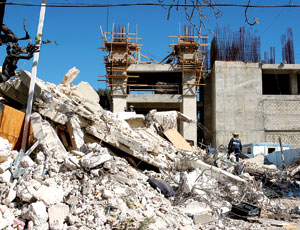By the time they leave on Jan. 28, the 10 U.S. structural engineers sent to Haiti to assess the condition of buildings slightly damaged in the magnitude-7 earthquake will have done about 100 surveys. However, some 100,000 buildings still will need to be inspected so that the sound structures can be reoccupied, say local sources.


The engineers surveyed hospitals, schools, warehouses, homes, government and United Nations buildings. Subsequently, St. Laundry Hospital in Petionville and Hospital Dash in Delmas were cleared to reopen.
The Jan. 12 temblor and its aftershocks destroyed hundreds of thousands of buildings, killing more than 150,000 people. One big issue is that people are apprehensive about going indoors for fear of more aftershocks. “We are trying to influence owners and the U.N. so that people may reoccupy” the safe buildings, says Andre Filiatrault, an engineering professor at State University of New York at Buffalo and the team’s leader. “It is very disturbing to see perfectly functional empty hospitals when in other areas of Port-au-Prince patients are being treated outside under tents in the heat.”
The engineers use the Applied Technology Council’s rapid evaluation safety assessment method as a basis for their work. Buildings are tagged red if they are unsafe to occupy, yellow if they can have restricted use and green if they are safe. The group, the first of many, was organized by the Appropriate Infrastructure Development Group, which is a U.S. organization that aids developing countries, and the Multidisciplinary Center for Earthquake Engineering Research (MCEER) at SUNY Buffalo on behalf of U.N. Operations.
The inspection effort is needed and welcome, say sources. Still, “Ten engineers is a pittance” for this magnitude of a disaster, says Daniel O’Neil, country director for the Pan American Development Foundation of the Organization of American States, a relief organization.
O’Neil, a Dominican Republic-based highway engineer with a staff of 150 in Haiti, says he underestimated the human trauma when he arrived. From Jan. 19 to 24, O’Neil accompanied seismic engineer H. Kit Miyamoto, CEO of the Los Angeles-based Miyamoto International, on inspections of 16 buildings for PADF. This included PADF’s offices, which Miyamoto deemed safe to reoccupy.
The Presidential Palace is one success story of the PADF-led work. Though the center of the two-story building collapsed, the wings did not; they are being readied for reoccupation. Miyamoto says his biggest surprise was that the collapsed U.N. building had no seismic strengthening. “It’s just unthinkable,” he says.
What wasn’t surprising to the experts, though, were the myriad collapses of nonductile concrete frames with concrete block infill and vulnerable “soft” first stories. Soft-story buildings are raised on stilts, with no diaphragm walls. Often, the ground level is used for parking.
Commonly observed problems include a lack of transverse reinforcement, poor-quality concrete and severe lack of symmetry. “We were in a warehouse with two parallel walls with completely different structural systems,” says Reginald DesRoches, an engineering professor at Georgia Institute of Technology and one of the MCEER team members.
Eduardo Fierro, a principal at seismic engineer Bertero Fierro Perry Engineers, Berkeley, Calif., surveyed buildings, powerplants, the port and bridges. A reinforcing-steel plant is in shambles because its light-metal roof hadn’t been properly connected to its concrete columns. Fierro and other sources observed widespread destruction of concrete frames not designed for lateral loads. Many rubble or unreinforced masonry walls failed.
The center of the E-in-plan Presidential Palace still has much of the first floor intact, with windows unbroken, but there is total collapse above it. Very light reinforcing is evident in failed columns near the entry. At the port, there is a collapsed pier and cranes, and several buildings are under water. Extensive lateral spreading and liquefaction is evident.
Organizing Reconstruction
International organization for reconstruction is off to a measured start. Canada’s foreign minister, Lawrence...



Post a comment to this article
Report Abusive Comment